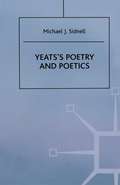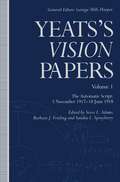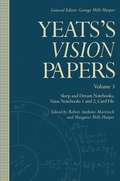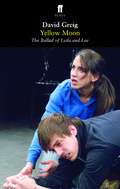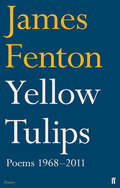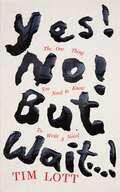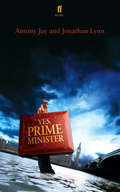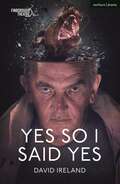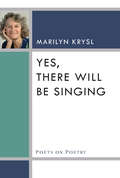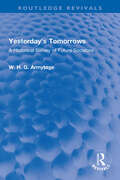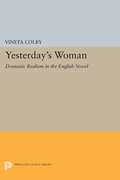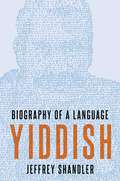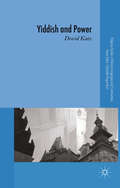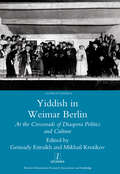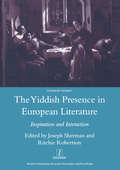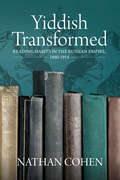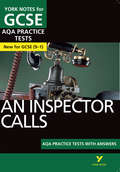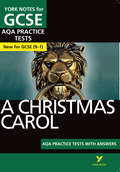- Table View
- List View
Yeats’s Poetry and Poetics
by Michael J. SidnellYeats's Poetry and Poetics brings together some of the finest Yeats criticism ever published, together with some new pieces specially written for this volume. Spanning the whole of Yeats's career, the essays are organised into three main parts. The first deals with Yeats's concern with the speaking voice and its bearing on public and private readings of his verse; and on his use of certain kinds of images in his poetry and plays, from ghosts and fairies, to figures borrowed from painters and sculptors and, extraordinarily, to the actual dancer for whom he makes room in his work. The second section puts Yeats's poetry in context with the work of Synge, D.H. Lawrence, Walter de la Mare and other 'Georgians', and with that of T.S. Eliot and other modernists; assessing the continuities (real and asserted) in Yeats's long poetic career against the revolutions in the poetry of his time. The profound connections between the writings of Yeats and Joyce, including the coupling of Finnegans's Wake and 'The Wanderings of Oisin' are also examined. Rounding off the volume 'Phantasmagoria', explores the implications for his poetics of Yeats's spiritualist philosophy, especially in terms of his conception of the poetic self, and, finally, the last section analyses two works animated by Yeats's quest for the 'faery bride' and his desperate attempt to attract, through his work, a real one.
Yeats's "Vision" Papers: The Automatic Script - 5 November, 1917 to 23 September, 1918 (Yeats's 'Vision' Papers)
by W. B. YeatsThe first volume of a three-volume edition of the collected papers and notebooks which comprise the "automatic writing" of W.B.Yeats. This material, which spans the years between 1917 and 1920, contains Yeats' thoughts concerning literature and art, which in turn, comprises his "vision".
Yeats’s Vision Papers: Volume 3: Sleep and Dream Notebooks, Vision Notebooks 1 and 2, Card File (Yeats's 'Vision' Papers)
by W. B. YeatsThe third volume of a three volume edition of the collected papers and notebooks which comprise the "automatic writing" of W.B.Yeats. The material presented here is taken from the writings known as "the sleep and dreams" notebooks, the "vision" notebooks one and two and from Yeats' card files.
Yellow Moon: The Ballad Of Leila And Lee
by David GreigYellow Moon is a modern Bonnie and Clyde tale that follows the fortunes of two teenagers on the run. Silent Leila is an introverted girl who has a passion for celebrity magazines. Stag Lee Macalinden is the deadest of dead-end kids in a dead-end town. They never meant to get mixed up in a murder... but now they need a place to hide.Yellow Moon explores what it means to live in a celebrity-obsessed world and what it is that defines who you are when you're 17 years old. The play premiered at the Circle Studio of Citizens' Theatre, Glasgow, in September 2006, and won the 2008 Brain Way Award for Best Play for Young People.
Yellow Tulips: Poems 1968–2011
by James FentonWinner of both the Queen's Gold Medal and the Whitbread Prize for Poetry, James Fenton has given readers some of the most memorable lyric verse of the past decades, from the formal skill that marked his debut, Terminal Moraine, to the dramatic and political monologues of The Memory of War and Children in Exile, through to the unforgettable love poems of Out of Danger and his most recent work: Poems is an essential selection by, as Stephen Spender put it, 'a brilliant poet of technical virtuosity'.Don't talk to me of love. I've had an earfulAnd I get tearful when I've downed a drink or two.I'm one of your talking wounded.I'm a hostage. I'm maroonded.But I'm in Paris with you.From 'In Paris With You' by James Fenton
Yes! No! But Wait...!: The One Thing You Need to Know To Write a Novel
by Tim LottAt the heart of writing – at the apex of storytelling – there is only one principle, and it winds like a golden thread across all the books and courses. But it gets lost in the ever-spreading panoply of detail that the creative writing industry relies on to keep its wheels turning. This book pulls out that thread, polishes it and reveals the way it penetrates storytelling. It will be invaluable to anyone creating fictional worlds - but most particularly to novelists, who are most in danger of forgetting it. Or not noticing it in the first place. Tim Lott knows he can’t teach anyone to write a novel (that’s one of the lies propagated by the novel-writing industry). But he can teach someone how to build a firm platform on which they can stand in order to explore whether they have the talent, will and determination that writing a novel takes.
Yes Prime Minister: a play
by Antony Jay Jonathan LynnYes, Minister, and the equally successful sequel Yes, Prime Minister captured a niche in the political consciousness of the nation. First broadcast thirty years ago, the original writers of these classic series have reunited to create a bang up to date Yes, Prime Minister for the stage. Spin, blackberries, sexed-up dossiers, sleaze, global warming and a country on the brink of financial meltdown form the backdrop to mayhem at Chequers as the Foreign Minister of Kumranistan makes a seriously compromising offer of salvation. Prime Minister Jim Hacker remains in power with his coterie of close advisors including Cabinet Secretary Sir Humphrey Appleby and Principal Private Secretary Bernard Woolley, but for how long? They govern a whole new world. Yes, Prime Minister premiered in the Festival Theatre, Chichester, in May 2010.
Yes So I Said Yes (Modern Plays)
by David IrelandIt's harder to kill people when there's a peace process on.Ulster Loyalist Alan Black is kept awake every night by his neighbour McCorrick's dog barking. To add to his difficulties, McCorrick refuses to acknowledge that he even owns a dog, let alone one that is creating a disturbance.In a Northern Ireland he barely recognises, where politics has proved just to be the continuation of war by other means, a disconsolate Alan sets out to rid himself of the incessant noise. As he seeks help from authority figures, he finally – as a very last resort – turns to the only voice he can really trust, Eamonn Holmes…Coinciding with the 100th anniversary of the partition of Ireland and the foundation of Northern Ireland, Yes So I Said Yes is a blackly comic, ferocious, dystopian satire about what it's like to feel alone in a place where everyone else is conspiring to erase you and your history.This edition was published to coincide with the production at London's Finborough Theatre in November 2021.
Yes So I Said Yes (Modern Plays)
by David IrelandIt's harder to kill people when there's a peace process on.Ulster Loyalist Alan Black is kept awake every night by his neighbour McCorrick's dog barking. To add to his difficulties, McCorrick refuses to acknowledge that he even owns a dog, let alone one that is creating a disturbance.In a Northern Ireland he barely recognises, where politics has proved just to be the continuation of war by other means, a disconsolate Alan sets out to rid himself of the incessant noise. As he seeks help from authority figures, he finally – as a very last resort – turns to the only voice he can really trust, Eamonn Holmes…Coinciding with the 100th anniversary of the partition of Ireland and the foundation of Northern Ireland, Yes So I Said Yes is a blackly comic, ferocious, dystopian satire about what it's like to feel alone in a place where everyone else is conspiring to erase you and your history.This edition was published to coincide with the production at London's Finborough Theatre in November 2021.
Yes, There Will Be Singing: Yes, There Will Be Singing (Poets On Poetry)
by Marilyn KryslYes, There Will Be Singing brings together Marilyn Krysl’s essays on the origins of language and poetry, poetic form, the poetry of witness, and poetry’s collaboration with the healing arts. Beginning with pieces on her own origins as a poet, she branches into poetry’s profound spiritual and political possibilities, drawing on rich examples from poets such as Anna Akhmatova, W.S. Merwin, and Vénus Khoury-Ghata. Krysl concludes with a selection of stories of her nursing and humanitarian work, powerfully connecting poetic expression with a generous and compassionate worldview.
Yesterday's Tomorrows: A Historical Survey of Future Societies (Routledge Revivals)
by W. H. ArmytageFirst published in 1968, Yesterday’s Tomorrows elucidates on the favourite occupation of man: forecasting the future. By man’s predictions, he mirrors his own wish-fulfilments, displacements, projections, denials, evasions and withdrawals. These predications can take the form of countries of the imagination, ‘mirror worlds’ like Rabelais’ Ever-Ever lands or the Erewhon of Butler. Alternatively, they may spring from panic, reflecting fear rather than hope, often manifesting themselves, in our technological age, as reports of ‘flying saucers’ or invasions from another planet. In either form, they provide philosophers, scientists, doctors and sociologists with material for evaluating man’s future needs, offering both criticism of our present society, plans for our future, and release from tension and disequilibrium. Professor Armytage shows in this book how such ‘visions’ can, and do, refresh minds for renewed grappling with the present by arming them with ideas for man’s future needs. He indicates that, out of an apparent welter of futuristic fantasies, a constructive debate about tomorrow is emerging, providing us with operational models of what tomorrow could be. This book will hold special interest for students of philosophy and of English literature.
Yesterday's Tomorrows: A Historical Survey of Future Societies (Routledge Revivals)
by W. H. ArmytageFirst published in 1968, Yesterday’s Tomorrows elucidates on the favourite occupation of man: forecasting the future. By man’s predictions, he mirrors his own wish-fulfilments, displacements, projections, denials, evasions and withdrawals. These predications can take the form of countries of the imagination, ‘mirror worlds’ like Rabelais’ Ever-Ever lands or the Erewhon of Butler. Alternatively, they may spring from panic, reflecting fear rather than hope, often manifesting themselves, in our technological age, as reports of ‘flying saucers’ or invasions from another planet. In either form, they provide philosophers, scientists, doctors and sociologists with material for evaluating man’s future needs, offering both criticism of our present society, plans for our future, and release from tension and disequilibrium. Professor Armytage shows in this book how such ‘visions’ can, and do, refresh minds for renewed grappling with the present by arming them with ideas for man’s future needs. He indicates that, out of an apparent welter of futuristic fantasies, a constructive debate about tomorrow is emerging, providing us with operational models of what tomorrow could be. This book will hold special interest for students of philosophy and of English literature.
Yesterday's Woman: Domestic Realism in the English Novel
by Vineta ColbyEncouraged by the response of the avid novel-reading public in early nineteenth-century England, minor novelists produced a staggering number of volumes that shaped styles, formed attitudes, and gave to the novel a new status and respectability. These novels were read by both sexes, but the majority were written by women. Vineta Colby examines the works of such minor novelists as Mrs. Gore, Maria Edgeworth, Charlotte Yonge, and Harriet Martincau, arguing that they prepared the way for the novels of the great Victorian era.Antiromantic and bourgeois in spirit, these domestic novels were concerned with daily living in ordinary society. As the form developed, the novels turned away from "idle romance" to a serious treatment of basic questions of human and social values. Professor Colby demonstrates how the preoccupation with high society, childhood, and village life laid the thematic foundations for the more sophisticated works of the later Victorians. The author concludes by showing that the disruption of the family unit by technology, urbanization, and scientific materialism led the domestic novel into the realms of literary naturalism and social realism.Originally published in 1974.The Princeton Legacy Library uses the latest print-on-demand technology to again make available previously out-of-print books from the distinguished backlist of Princeton University Press. These editions preserve the original texts of these important books while presenting them in durable paperback and hardcover editions. The goal of the Princeton Legacy Library is to vastly increase access to the rich scholarly heritage found in the thousands of books published by Princeton University Press since its founding in 1905.
Yiddish: Biography of a Language
by Jeffrey ShandlerThe most widely spoken Jewish language on the eve of the Holocaust, Yiddish continues to play a significant role in Jewish life today, from Hasidim for whom it is a language of daily life to avant-garde performers, political activists, and LGBTQ writers turning to Yiddish for inspiration. Yiddish: Biography of a Language presents the story of this centuries-old language, the defining vernacular of Ashkenazi Jews, from its origins to the present. Jeffrey Shandler tells the multifaceted history of Yiddish in the form of a biographical profile, revealing surprising insights through a series of thematic chapters. He addresses key aspects of Yiddish as the language of a diasporic population, whose speakers have always used more than one language. As the vernacular of a marginalized minority, Yiddish has often been held in low regard compared to other languages, and its legitimacy as a language has been questioned. But some devoted Yiddish speakers have championed the language as embodying the essence of Jewish culture and a defining feature of a Jewish national identity. Despite predictions of the demise of Yiddish-dating back well before half of its speakers were murdered during the Holocaust-the language leads a vibrant, evolving life to this day.
Yiddish: Biography of a Language
by Jeffrey ShandlerThe most widely spoken Jewish language on the eve of the Holocaust, Yiddish continues to play a significant role in Jewish life today, from Hasidim for whom it is a language of daily life to avant-garde performers, political activists, and LGBTQ writers turning to Yiddish for inspiration. Yiddish: Biography of a Language presents the story of this centuries-old language, the defining vernacular of Ashkenazi Jews, from its origins to the present. Jeffrey Shandler tells the multifaceted history of Yiddish in the form of a biographical profile, revealing surprising insights through a series of thematic chapters. He addresses key aspects of Yiddish as the language of a diasporic population, whose speakers have always used more than one language. As the vernacular of a marginalized minority, Yiddish has often been held in low regard compared to other languages, and its legitimacy as a language has been questioned. But some devoted Yiddish speakers have championed the language as embodying the essence of Jewish culture and a defining feature of a Jewish national identity. Despite predictions of the demise of Yiddish-dating back well before half of its speakers were murdered during the Holocaust-the language leads a vibrant, evolving life to this day.
Yiddish and Power: Ten Overhauls Of A Stateless Language (Palgrave Studies in Minority Languages and Communities)
by D. KatzYiddish and Power surveys the social, linguistic and intellectual history of the Yiddish language within the traditional civilisation of Jewish Ashkenaz in central, and then in eastern Europe, and its interaction with the surrounding non-Jewish culture. It explores the various ways in which Yiddish has empowered masses and served political agendas.
Yiddish in Weimar Berlin: At the Crossroads of Diaspora Politics and Culture
by Gennady Estraikh"Berlin emerged from the First World War as a multicultural European capital of immigration from the former Russian Empire, and while many Russian emigres moved to France and other countries in the 1920s, a thriving east European Jewish community remained. Yiddish-speaking intellectuals and activists participated vigorously in German cultural and political debate. Multilingual Jewish journalists, writers, actors and artists, invigorated by the creative atmosphere of the city, formed an environment which facilitated exchange between the main centres of Yiddish culture: eastern Europe, North America and Soviet Russia. All this came to an end with the Nazi rise to power in 1933, but Berlin remained a vital presence in Jewish cultural memory, as is testified by the works of Sholem Asch, Israel Joshua Singer, Zalman Shneour, Moyshe Kulbak, Uri Zvi Grinberg and Meir Wiener. This volume includes contributions by an international team of leading scholars dealing with various aspects of history, arts and literature, which tell the dramatic story of Yiddish cultural life in Weimar Berlin as a case study in the modern European culture."
Yiddish in Weimar Berlin: At the Crossroads of Diaspora Politics and Culture
by Gennady Estraikh"Berlin emerged from the First World War as a multicultural European capital of immigration from the former Russian Empire, and while many Russian emigres moved to France and other countries in the 1920s, a thriving east European Jewish community remained. Yiddish-speaking intellectuals and activists participated vigorously in German cultural and political debate. Multilingual Jewish journalists, writers, actors and artists, invigorated by the creative atmosphere of the city, formed an environment which facilitated exchange between the main centres of Yiddish culture: eastern Europe, North America and Soviet Russia. All this came to an end with the Nazi rise to power in 1933, but Berlin remained a vital presence in Jewish cultural memory, as is testified by the works of Sholem Asch, Israel Joshua Singer, Zalman Shneour, Moyshe Kulbak, Uri Zvi Grinberg and Meir Wiener. This volume includes contributions by an international team of leading scholars dealing with various aspects of history, arts and literature, which tell the dramatic story of Yiddish cultural life in Weimar Berlin as a case study in the modern European culture."
The Yiddish Presence in European Literature: Inspiration and Interaction: Selected Papers Arising from the Fourth and Fifth International Mendel Friedman Conference
by Joseph Sherman"Early in the twentieth century, Yiddish, previously stigmatized as a corrupt jargon, came to be recognized as a language in its own right, and one moreover that was already the vehicle for a rich literature. Many writers in other European languages steadily became aware of the status and richness of the Yiddish language, sometimes by encountering Yiddish-speaking communities in Eastern Europe, and they responded to Yiddish language and culture in their own works, while Yiddish writers adopted, and sometimes anticipated, modern trends in other European literatures known to them. The collection of papers in this volume examines some of these fruitful interactions between Yiddish and the European literary tradition, ranging from the early nineteenth century to the present, from France to Lithuania, and from classic modernist writers such as Kafka to Imre Kertesz (Nobel Prize for Literature, 2002). With the contributions: Gilles Rozier- 'When Purim-shpiler meets Columbine': Characters of Commedia dell'arte and Purimshpil in the Works of Moyshe Broderzon David Bellos- In the Worst Possible Taste: Romain Gary's Dance of Genghis Cohn Florian Krobb- 'Muthwillige Faschingstracht': The Presence of Yiddish in Nineteenth-Century German Literature Ritchie Robertson- Kafka's Encounter with the Yiddish Theatre David Groiser- Translating Yiddish: Martin Buber and David Pinski Mikhail Krutikov- Yiddish Author as Cultural Mediator: Meir Wiener's Unpublished Novel David Midgley- The Romance of the East: Encounters of German-Jewish Writers with Yiddish-Speaking Communities, 1916-27 PolO Dochartaigh - Intimacy and Alienation: Yiddish in the Works of Jurek Becker Peter Sherwood- 'Living through Something': Notes on the Work of Imre Kertesz Joseph Sherman- Bergelson and Chekhov: Convergences and Departures Gennady Estraikh- Shmuel Gordon: A Yiddish Writer in 'the Ocean of Russian Literature'"
The Yiddish Presence in European Literature: Inspiration and Interaction: Selected Papers Arising from the Fourth and Fifth International Mendel Friedman Conference
by Joseph Sherman"Early in the twentieth century, Yiddish, previously stigmatized as a corrupt jargon, came to be recognized as a language in its own right, and one moreover that was already the vehicle for a rich literature. Many writers in other European languages steadily became aware of the status and richness of the Yiddish language, sometimes by encountering Yiddish-speaking communities in Eastern Europe, and they responded to Yiddish language and culture in their own works, while Yiddish writers adopted, and sometimes anticipated, modern trends in other European literatures known to them. The collection of papers in this volume examines some of these fruitful interactions between Yiddish and the European literary tradition, ranging from the early nineteenth century to the present, from France to Lithuania, and from classic modernist writers such as Kafka to Imre Kertesz (Nobel Prize for Literature, 2002). With the contributions: Gilles Rozier- 'When Purim-shpiler meets Columbine': Characters of Commedia dell'arte and Purimshpil in the Works of Moyshe Broderzon David Bellos- In the Worst Possible Taste: Romain Gary's Dance of Genghis Cohn Florian Krobb- 'Muthwillige Faschingstracht': The Presence of Yiddish in Nineteenth-Century German Literature Ritchie Robertson- Kafka's Encounter with the Yiddish Theatre David Groiser- Translating Yiddish: Martin Buber and David Pinski Mikhail Krutikov- Yiddish Author as Cultural Mediator: Meir Wiener's Unpublished Novel David Midgley- The Romance of the East: Encounters of German-Jewish Writers with Yiddish-Speaking Communities, 1916-27 PolO Dochartaigh - Intimacy and Alienation: Yiddish in the Works of Jurek Becker Peter Sherwood- 'Living through Something': Notes on the Work of Imre Kertesz Joseph Sherman- Bergelson and Chekhov: Convergences and Departures Gennady Estraikh- Shmuel Gordon: A Yiddish Writer in 'the Ocean of Russian Literature'"
Yiddish Transformed: Reading Habits in the Russian Empire, 1860-1914
by Nathan CohenAs significant economic, social, political, and cultural transformations swept the Jewish population of Tsarist Russia and Congress Poland between 1860 and 1914, the Yiddish language (Zhargon) began to gain recognition as a central part of the Jewish cultural stage. Yiddish Transformed examines the secular reading habits of East-European Jews as the Jewish community began shifting to a modern society. Author Nathan Cohen explores Jewish reading practices alongside the rise of Yiddish by delving into publishing policies of Yiddish books and newspapers, popular literary genres of the time, the development of Jewish public libraries, as well as personal reflections of reading experiences.
Yiddish Transformed: Reading Habits in the Russian Empire, 1860-1914
by Nathan CohenAs significant economic, social, political, and cultural transformations swept the Jewish population of Tsarist Russia and Congress Poland between 1860 and 1914, the Yiddish language (Zhargon) began to gain recognition as a central part of the Jewish cultural stage. Yiddish Transformed examines the secular reading habits of East-European Jews as the Jewish community began shifting to a modern society. Author Nathan Cohen explores Jewish reading practices alongside the rise of Yiddish by delving into publishing policies of Yiddish books and newspapers, popular literary genres of the time, the development of Jewish public libraries, as well as personal reflections of reading experiences.
Yiddish Transformed: Reading Habits in the Russian Empire, 1860-1914
by Nathan CohenAs significant economic, social, political, and cultural transformations swept the Jewish population of Tsarist Russia and Congress Poland between 1860 and 1914, the Yiddish language (Zhargon) began to gain recognition as a central part of the Jewish cultural stage. Yiddish Transformed examines the secular reading habits of East-European Jews as the Jewish community began shifting to a modern society. Author Nathan Cohen explores Jewish reading practices alongside the rise of Yiddish by delving into publishing policies of Yiddish books and newspapers, popular literary genres of the time, the development of Jewish public libraries, as well as personal reflections of reading experiences.
Yna5 Aic Gcse Lit Practice Tests: - the best way to practise and feel ready for 2022 and 2023 assessments and exams (York Notes)
by Jo HeathcoteLearn - With seven practice tests to work through, you'll get to grips with exam-style questions and the skills examiners are looking for. Use the write-in space to plan and write mark-maximising answers. Practise - Test yourself using the annotated sample answers and see your abilities grow. Feel proud of your progress as you put your knowledge to the test, perfect your skills and start getting more answers right more often. Pass - With York Notes Practice Tests, you can go into your exams feeling confident about writing your best possible responses.
Yna5 Cc Gcse Lit Practice Tests: - the best way to practise and feel ready for 2022 and 2023 assessments and exams (York Notes)
by Beth KempLearn - With seven practice tests to work through, you'll get to grips with exam-style questions and the skills examiners are looking for. Use the write-in space to plan and write mark-maximising answers. Practise - Test yourself using the annotated sample answers and see your abilities grow. Feel proud of your progress as you put your knowledge to the test, perfect your skills and start getting more answers right more often. Pass - With York Notes Practice Tests, you can go into your exams feeling confident about writing your best possible responses.
